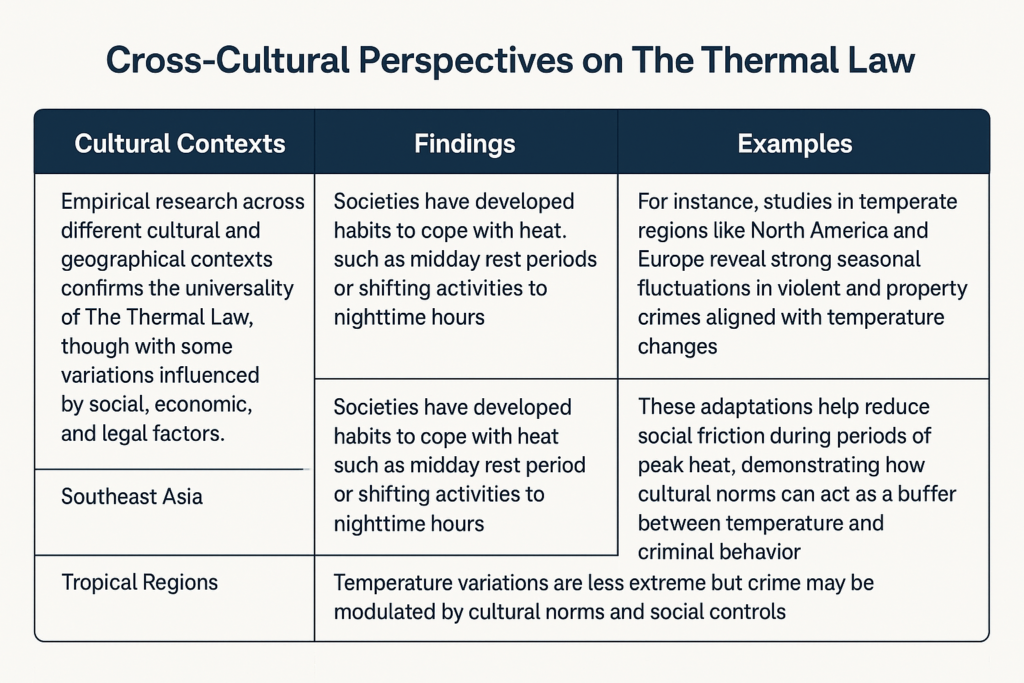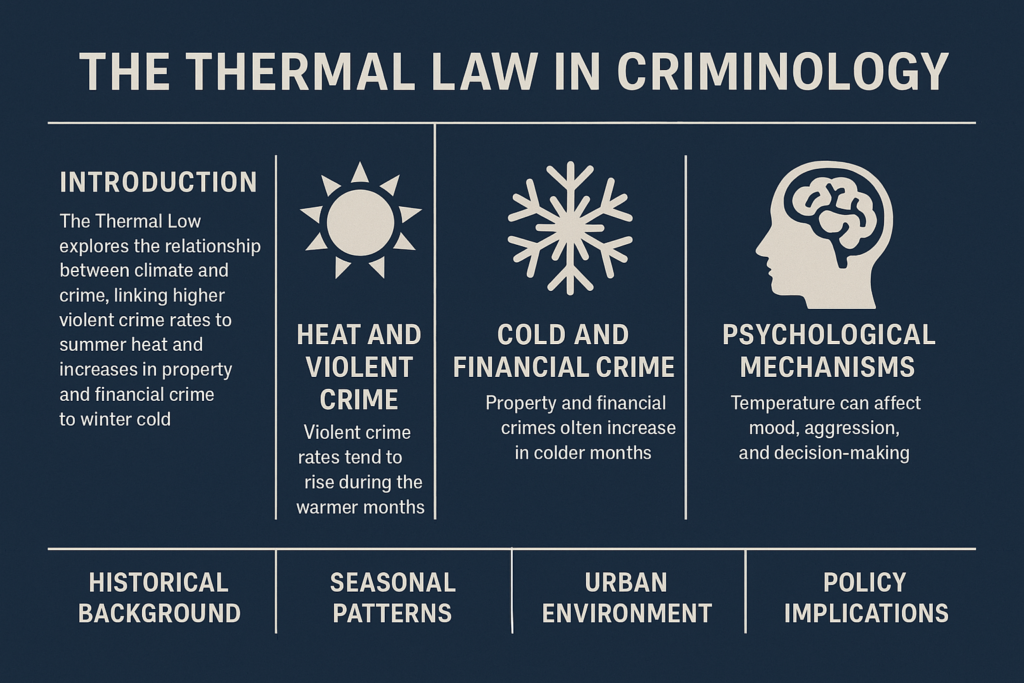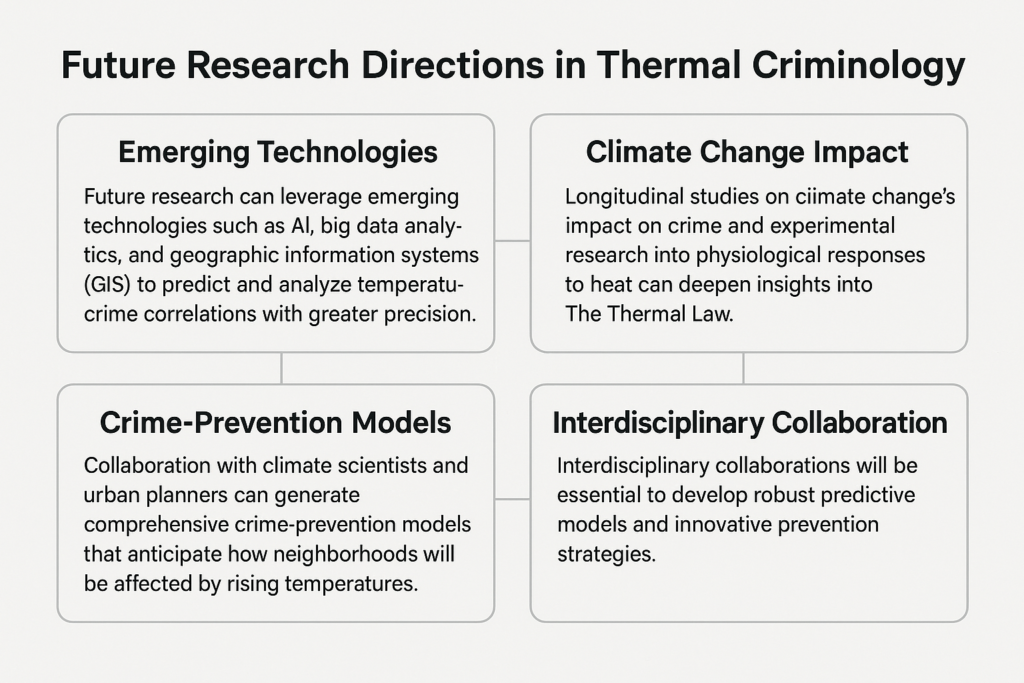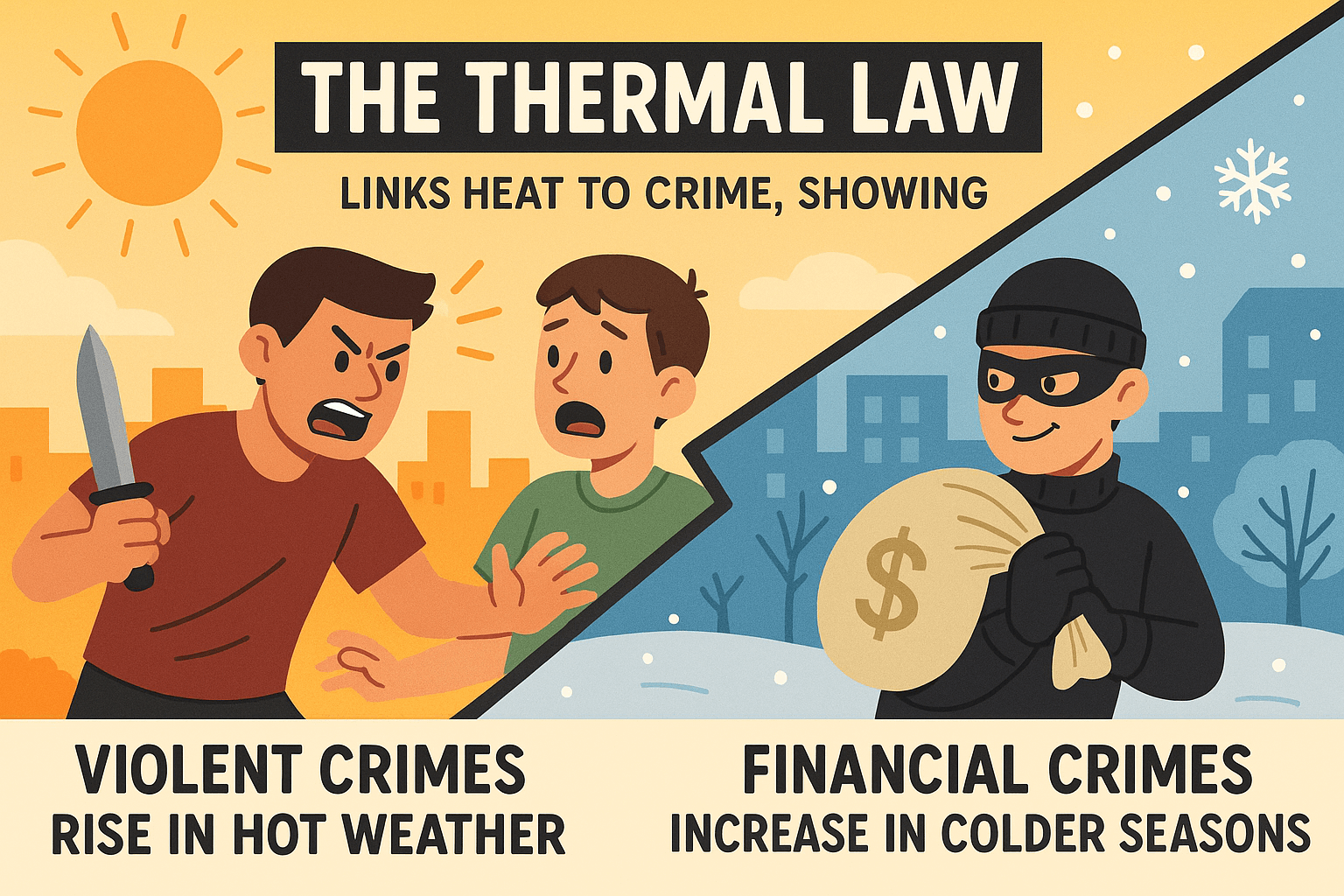1. Introduction: Understanding The Thermal Law in Criminology
The study of crime patterns and their causes has long intrigued sociologists, psychologists, and criminologists alike. One fascinating area of research that has gained significant attention is The Thermal Law—a concept that connects climatic temperature variations with fluctuations in criminal behavior. Simply put, The Thermal Law observes that violent crimes tend to spike during hot seasons, particularly summer, whereas non-violent or financial crimes show an increase during colder months like winter. This correlation suggests that temperature and seasonal changes may exert a powerful influence on human behavior and social dynamics, thereby impacting crime rates.
In addition, the rising temperatures in major cities create psychologically stressful environments, especially in underprivileged neighborhoods lacking ventilation and green public spaces. These stressors foster social tension and disputes, which together form fertile ground for violent behavior, particularly during peak heatwaves in the summer months.
Understanding The Thermal Law not only enriches criminological theory but also offers valuable insights for crime prevention strategies and public policy, especially in an era increasingly affected by global climate change. This article explores The Thermal Law from multiple angles, integrating historical perspectives, physiological insights, sociological theories, and modern empirical research.
2. Historical Background and Theoretical Foundations
The relationship between climate and human behavior is not a new subject. Early thinkers, including the great Arab historian Ibn Khaldun, observed that heat affects human temperament and social order. Ibn Khaldun theorized that hot climates foster impulsive and aggressive behavior, a notion strikingly aligned with modern interpretations of The Thermal Law. Later European philosophers such as Montesquieu echoed similar ideas, emphasizing the impact of environment on human societies.
It is also worth noting that other thinkers, such as the 19th-century French physician Adolphe Quetelet, analyzed crime statistics and linked them to weather and seasons. Quetelet observed an increase in violent crimes during summer and attributed this to natural factors influencing human behavior. He argued that crime follows seasonal patterns that can be studied and predicted, challenging the notion of crime as a purely random phenomenon.
In modern criminology, The Thermal Law gained empirical support through statistical analyses showing seasonal crime trends. Research consistently indicates that violent crimes such as assaults, homicides, and riots peak in warmer months. Conversely, winter months often see a rise in non-violent offenses, including fraud and embezzlement. Theoretical explanations range from physiological responses to heat, changes in routine activities, and social interaction patterns affected by weather.
3. Physiological Effects of Heat on Human Behavior
The physiological impact of temperature on the human body and brain plays a crucial role in explaining The Thermal Law. Heat affects the central nervous system, increasing irritability and decreasing tolerance to frustration. Elevated body temperature can impair cognitive functions and heighten emotional responses, making individuals more prone to aggressive and impulsive behaviors.
Additionally, studies have shown that prolonged exposure to high temperatures can cause changes in brain chemistry, particularly in areas responsible for emotional regulation such as the amygdala. These changes can lead to diminished self-control and an increase in aggressive behaviors, especially among individuals with pre-existing psychological disorders.
Neuroscientific studies show that heat stress triggers hormonal changes, including increased cortisol levels, which are associated with stress and aggression. Furthermore, discomfort caused by heat can lead to sleep disturbances, further exacerbating irritability and reducing impulse control. These biological mechanisms help explain why violent crimes escalate during hotter periods.
4. Seasonality and Crime Patterns: Violent vs. Non-Violent Crimes
Seasonal patterns in crime are well-documented globally. Violent crimes, including assaults, domestic violence, and homicide, show marked increases during spring and summer. Several factors contribute to this trend: higher temperatures induce physiological stress and aggression; people spend more time outdoors, increasing social interactions and potential conflicts; and alcohol consumption tends to rise in warm weather, further fueling violence.
On the other hand, some studies point out that summer recreational activities—such as parties, festivals, and sporting events—can contribute to rising social tensions and conflicts, leading to an increase in violent crime. In contrast, the long nights and reduced outdoor activity during winter create an environment more conducive to calculated economic crimes executed in enclosed spaces.
In contrast, winter months often see an increase in white-collar and property crimes. The colder weather reduces outdoor activities, shifting criminal opportunities indoors and toward more calculated, less impulsive offenses such as fraud, embezzlement, and cybercrime. This seasonal dichotomy is a central feature of The Thermal Law, highlighting how temperature influences not only crime volume but also its nature.
5. Routine Activity Theory and Environmental Factors
Routine Activity Theory posits that crime occurs when a motivated offender, a suitable target, and lack of capable guardianship converge in time and space. Temperature influences these dynamics by shaping daily routines and environmental exposure. Warm weather encourages outdoor activities, increasing the number of suitable targets and interactions, which can elevate crime opportunities.
Moreover, there is a clear link between Routine Activity Theory and how heat affects human mobility. In hot weather, people are more likely to be in public spaces, increasing the chances of both positive and negative social interactions. This makes temperature a potential catalyst for criminal encounters, especially when socioeconomic tensions are already high.
Conversely, colder temperatures limit outdoor socialization and mobility, reducing spontaneous encounters but potentially increasing opportunities for premeditated crimes conducted indoors. Thus, The Thermal Law intersects with routine activity patterns, showing how environmental factors modulate crime risks through behavioral changes.
6. Cross-Cultural Perspectives on The Thermal Law
Empirical research across different cultural and geographical contexts confirms the universality of The Thermal Law, though with some variations influenced by social, economic, and legal factors. For instance, studies in temperate regions like North America and Europe reveal strong seasonal fluctuations in violent and property crimes aligned with temperature changes.
One notable example is how some societies in Southeast Asia have developed cultural habits to cope with heat, such as midday rest periods or shifting activities to nighttime hours. These adaptations help reduce social friction during periods of peak heat, demonstrating how cultural norms can act as a buffer between temperature and criminal behavior.
In tropical regions, where temperature variations are less extreme but humidity levels are high, aggressive behaviors and crime patterns still correlate with heat stress but may be modulated by cultural norms and social controls. These cross-cultural analyses underscore the complex interplay between climate, culture, and crime.

7. Urban Design, Environmental Exposure, and Crime Rates
Urban environments profoundly influence how temperature affects crime. High-density areas with poor ventilation and limited green spaces can amplify heat stress, exacerbating aggressive tendencies among residents. Conversely, well-designed urban spaces with shaded areas, parks, and cooling infrastructures can mitigate heat’s psychological effects, potentially reducing heat-related violence.
Modern innovations include smart cities that use urban cooling technologies such as reflective surfaces, shaded walkways, and cooled pavements. Additionally, designing green spaces and shaded areas has been shown to reduce social aggression tied to heat. In contrast, industrial or overcrowded areas with poor infrastructure often remain crime hotspots during summer.
Environmental exposure also includes factors such as noise pollution and overcrowding, which combined with high temperatures, create stressful conditions conducive to crime. Urban planning that considers thermal comfort and social interaction can play a key role in crime prevention strategies.

8. Psychological and Social Mechanisms Behind Thermal Effects
Beyond physiological reactions, temperature influences psychological states and social dynamics. Heat can worsen mood disorders, increase anxiety, and reduce patience, which may escalate conflicts. Social stressors, like overcrowding during hot seasons, amplify tensions within communities.
Social psychologists have documented how high temperatures increase the likelihood of hostile attribution bias—that is, individuals are more likely to interpret neutral actions as hostile. This phenomenon contributes to heightened interpersonal conflict in public spaces during hot weather, leading to an uptick in assaults and altercations.
Moreover, social norms and collective behavior often shift seasonally, influencing law enforcement efficacy and community vigilance. These psychological and social mechanisms help explain why The Thermal Law manifests not only biologically but also through complex human interactions.
9. Case Studies: Empirical Evidence from Global Cities
Cities such as Chicago, Cairo, and Tokyo provide rich case studies demonstrating The Thermal Law. For example, Chicago’s violent crime rates spike noticeably during heatwaves, corroborated by police reports and hospital admissions. In Cairo, summer heat exacerbates social tensions, coinciding with increased instances of street violence.
In Buenos Aires, police records show a noticeable increase in incidents of domestic violence and road rage during summer months. Similarly, studies in Mumbai confirm a correlation between heat stress and violent outbreaks in overcrowded districts, especially when combined with power outages and limited water access.
Tokyo’s well-documented seasonal crime data reveals not only the summer rise in assaults but also winter peaks in financial crimes. These case studies illustrate The Thermal Law’s practical relevance across diverse urban settings.
10. The Thermal Law in the Context of Climate Change
Global climate change introduces new complexities to The Thermal Law. Rising average temperatures and more frequent heatwaves may lead to sustained increases in violent crime in many regions. At the same time, extreme weather events and unpredictable seasonal patterns could disrupt traditional crime seasonality.
For example, cities experiencing intensified heatwaves without adequate cooling infrastructure may face social unrest. Long-term climate shifts could also change traditional crime timelines, requiring criminologists to re-evaluate historical crime models. These evolving conditions underscore the urgent need for climate-sensitive crime analysis.
Understanding these changes is critical for policymakers and law enforcement agencies to adapt crime prevention measures to emerging climatic realities. Climate-informed criminology is becoming an essential field to address future social challenges.
11. Policy Implications and Crime Prevention Strategies
Acknowledging The Thermal Law has practical policy implications. Governments and law enforcement can implement heat-specific crime prevention measures such as increasing police presence during hot months, providing cooling centers to reduce public heat stress, and designing urban spaces that alleviate thermal discomfort.
Additionally, public service campaigns can raise awareness about the effects of heat on behavior, promoting conflict resolution and emotional regulation during high-risk periods. Cities should also integrate temperature metrics into predictive policing models to better allocate resources.
Education and public awareness campaigns can also address heat-induced aggression. Tailoring crime prevention strategies seasonally enhances their effectiveness and helps mitigate climate-related crime spikes.
12. Integrating The Thermal Law with Other Criminological Theories
The Thermal Law complements and enriches other criminological frameworks. For example, it supports biological theories linking physiological stress to aggression, aligns with social disorganization theory by highlighting environmental stressors, and complements routine activity theory by explaining how climate shapes opportunity structures.
Some researchers have proposed integrating thermal variables into the strain theory framework, arguing that prolonged exposure to environmental discomfort acts as a source of chronic stress, which in turn increases the likelihood of criminal coping mechanisms. This interdisciplinary synthesis provides a fuller understanding of the causes of crime in climate-sensitive environments.
A multidisciplinary approach combining thermal, social, psychological, and economic factors offers the most comprehensive understanding of crime patterns.
13. Future Research Directions in Thermal Criminology
Future research can leverage emerging technologies such as AI, big data analytics, and geographic information systems (GIS) to predict and analyze temperature-crime correlations with greater precision. Longitudinal studies on climate change’s impact on crime and experimental research into physiological responses to heat can deepen insights into The Thermal Law.
Moreover, collaboration with climate scientists and urban planners can generate comprehensive crime-prevention models that anticipate how neighborhoods will be affected by rising temperatures. This predictive capacity is crucial for designing effective public safety measures in an era of rapid environmental transformation.
Interdisciplinary collaborations will be essential to develop robust predictive models and innovative prevention strategies.

14. Conclusion: Toward a Climate-Informed Criminology
The Thermal Law represents a vital frontier in criminology, revealing how climatic and environmental factors intricately shape crime patterns worldwide. As the planet warms, integrating thermal considerations into criminological theory and policy becomes increasingly urgent.
In sum, understanding the relationship between temperature and crime is no longer a secondary issue—it is a cornerstone for building adaptive, climate-conscious criminological frameworks that can address the evolving challenges of crime in a warming world.
By understanding and addressing the multifaceted impacts of temperature on human behavior, societies can develop smarter, climate-adaptive approaches to crime prevention—ushering in a new era of climate-informed criminology.
References
- Anderson, C. A., Bushman, B. J., & Groom, R. W. (2021). Temperature, crime, and violence: A systematic review and meta-analysis. Environmental Health Perspectives. Retrieved from https://ehp.niehs.nih.gov/doi/full/10.1289/EHP14300
- Pinkerton Risk Management. (2022). The Seasonality of Crime. Retrieved from https://pinkerton.com/our-insights/blog/the-seasonality-of-crime
- Ranson, M. (2023). How volatile temperatures shape violent crime. ScienceDirect. Retrieved from https://www.sciencedirect.com/science/article/abs/pii/S0047235223000612
- Gamble, A., & Fothergill, A. (2022). Weather and crime: A systematic review of the empirical literature. Crime Science Journal. Retrieved from https://crimesciencejournal.biomedcentral.com/articles/10.1186/s40163-022-00179-8
- Hsiang, S. M., Burke, M., & Miguel, E. (2020). The climate change–temperature–crime hypothesis. SAGE Journals. Retrieved from https://journals.sagepub.com/doi/abs/10.1177/0306624X20969934
- Zhang, Y., & Lee, Y. (2024). Understanding the impact of urban heat islands on crime. Crime Science Journal. Retrieved from https://crimesciencejournal.biomedcentral.com/articles/10.1186/s40163-024-00214-w
- Wikipedia Contributors. (2024). Climate change and crime. Wikipedia. Retrieved from https://en.wikipedia.org/wiki/Climate_change_and_crime
- News.com.au. (2024). Crime-ate change: Shock link between rising temperatures and rising crime rates. Retrieved from https://www.news.com.au/technology/environment/climate-change/crimeate-change-shock-link-between-rising-temperatures-and-rising-crime-rates/news-story/dc0d219339b5a4bd9ac179440841696a
- Karim, S., & Singh, R. (2023). Forecasting seasonal criminality using SARIMA. arXiv. Retrieved from https://arxiv.org/abs/2306.03053
- D’Orsogna, M. R., & Perc, M. (2015). Statistical physics of crime: A review. arXiv. Retrieved from https://arxiv.org/abs/1411.1743

